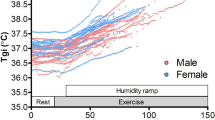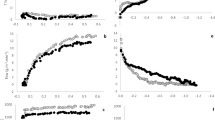Abstract
Eight older (60–65 years) and six younger (20–25 years) men were exposed to a standard heat stress for 60 min in summer, autumn, winter, and spring. The test consisted of placing the lower legs and feet in a 42°C water bath while sitting in constant environmental conditions (30°C and 45% relative humidity). The increase of rectal temperature (ΔT re) was significantly greater (P < 0.05) in autumn, winter, and spring than in summer for the older group, but significantly greater only in winter than in summer for the younger group (P < 0.05). The ΔT re was greater for the older group in all seasons, but of significance only in autumn and spring (P < 0.01). There were no significant season-related differences for metabolic heat production (m) and mean skin temperature (\(\overline T \) sk) during the heat test in the respective groups, although the m and\(\overline T \) sk were lower for the older group in all seasons (P < 0.01). In the older group total body sweating rate (msw) divided by ΔT re (total msw/ΔT re) decreased from summer to winter (P < 0.02) and did not differ between winter and spring, whereas total msw/ΔT re in the younger group increased in spring after decreasing from autumn to winter (P < 0.03). The variations of the value, local sweating rate on the back and thigh divided by ΔT re (back msw/ΔT re and thigh msw/ΔT re), were similar to those of the total msw/ΔT re in each group, except for back msw/ΔT re in the younger group, which did not increase from winter to spring. The total msw/ΔT re, back msw/ΔT re and thigh msw/ΔT re were significantly less for the older group in summer, autumn and spring (P < 0.05). The range of seasonal variations was significantly less for the older group (P < 0.001). The results indicated that, compared with younger men in older men, the enhancement of sweating function toward summer occurred later and its reduction toward winter occurred earlier despite a smaller range of seasonal variation and that older men had a somewhat lesser capability to maintainT re when challenged by heat stress in all seasons.
Similar content being viewed by others
References
Anderson RK, Kenney WL (1987) Effect of age on heat-activated sweat gland density and flow during exercise in dry heat. J Appl Physiol 63:1089–1094
Araki T, Inoue Y, Umeno K (1980) Effects of physical training on thermoregulatory responses to alternate stress of heat and cold. Jpn J Phys Fitness Sports Med 29:75–81
Araki T, Matsushita K, Umeno K, Tsujino A, Toda Y (1981) Effect of physical training on exercise-induced sweating in women. J Appl Physiol 51:1526–1532
Collins KJ (1966) The action of exogenous aldosterone on the secretion and composition of drug-induced sweat. Clin Sci 30:207–221
Crowe JP, Moore RE (1973) Physiological and behavioral responses of aged men to passive heating. J Physiol (Lond) 236:43–45
Drinkwater BL, Bedi JF, Loucks AB, Horvath SM (1982) Sweating senstivity and capacity of women in relation to age. J Appl Physiol 53:671–676
Fujimoto S, Watanabe T (1969) Studies on the body surface area of Japanese. Acta Med Nagasaki 13:1–13
Hardy RF, DuBois EF (1937) Regulation of heat loss from the human body. Proc Nat Acad Sci (Washington) 23:624–631
Hellon RF, Lind AR (1956) Observations on the activity of sweat glands with special reference to the influence of aging. J Physiol (Lond) 133:132–144
Henane R, Bittel J (1975) Change of thermal balance induced by passive heating in resting man. J Appl Physil 38:294–299
Ihzuka H, Hori S, Akamatsu T (1986) Seasonal variations of physiological responses to heat of subtropical and temperature natives. Int J Biometeor 30:107–113
Inoue Y, Nakao M, Matsushita K, Murakami H (1989) A practical method for estimating total oxygen uptake during exercise in elderly men. J Human Ergol 18:13–22
Inoue Y, Nakao M, Araki T, Murakami H (1991) Regional differences in the sweating responses of older and younger men. J Appl Physiol 71:2453–2459
Inoue Y, Nakao M, Araki T, Ueda H (1992) Thermoregulatory responses of young and older men to cold exposure. Eur J Appl Physiol 65:492–498
Kenney WL, Fowler SR (1988) Methylcholine-activated eccrine sweat gland density and output as a function of age. J Appl Physiol 65:1082–1086
Kirby CR, Convertino VA (1986) Plasma aldosterone and sweat sodium concentration after exercise and heat acclimation. J Appl Physiol 61:967–970
Nadel ER, Pandolf KB, Roberts MF, Stolwijik JAJ (1974) Mechanisms of thermal acclimation to exercise and heat. J Appl Physiol 37:515–520
Ogata K (1973) Adaptation (in Japanese). Ishiyaku, Tokyo, pp 59–76
Ohara K (1966) Chloride concentration in sweat, its individual, regional, seasonal and some other variations, and interrelations between them. Jpn J Physiol 16:274–290
Roberts MF, Wenger CB, Stolwijik JAJ, Nadel ER (1977) Skin blood flow and sweating changes following exercise training and heat acclimation. J Appl Physiol 43:133–137
Sagawa S, Shiraki K, Yousef MK, Miki K (1988) Sweating and cardiovascular responses of aged men to heat exposure. J Gerontol 43: M1–8
Sato K (1977) The physiology, pharmacology, and biochemistry of the eccrine sweat gland. Rev Physiol Biochem Pharmacol 79:51–131
Shoenfeld Y, Udassin R, Shapiro Y, Ohri A, Sohar E (1978) Age and sex differences in response to short exposure to extreme dry heat. J Appl Physiol 44:1–4
Smolander J, Korhonen O, Ilmarinen R (1990) Responses of young and older men during prolonged exercise in dry and humid heat. Eur J Appl Physiol 61:413–418
Wyndham CH (1967) Effect of acclimatization on the sweat rate/rectal temperature relationship. J Appl Physiol 22:27–30
Yousef MK, Dill DB, Vitez TS, Hillyard SD, Goldman AS (1984) Thermoregulatory responses to desert heat: age, race and sex. J Gerontol 39:406–414
Author information
Authors and Affiliations
Rights and permissions
About this article
Cite this article
Inoue, Y., Nakao, M., Okudaira, S. et al. Seasonal variation in sweating responses of older and younger men. Europ. J. Appl. Physiol. 70, 6–12 (1995). https://doi.org/10.1007/BF00601802
Accepted:
Issue Date:
DOI: https://doi.org/10.1007/BF00601802




